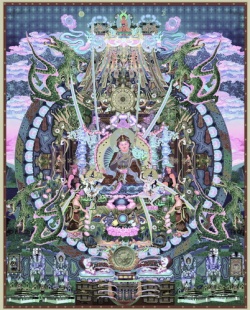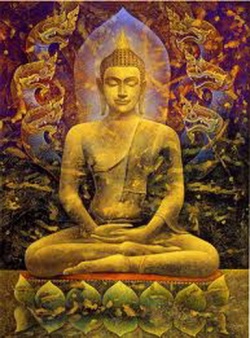Buddhism and Transcendental Visions
Buddhism and Transcendental Visions
By Indrajala (Jeffrey Kotyk)
In my discussions with Buddhists I often find that many think a transcendental vision of the Buddha is entirely a product of later Mahāyāna thinking. This is probably due to the fact that the only extant Śrāvaka school is Theravāda and their conception of Śākyamuni is not transcendental. However, we need to keep in mind the definition of "Buddha" differs from school to school in the greater historical context. Even amongst the early Śrāvaka schools there was no universal consensus on the qualities of the Buddha.
One good work which outlines this is Concept of the Buddha by Venerable Guang Xing.
Consider the following:
- The concept of the Buddha was significantly advanced at the time of the early Indian Buddhist schools, especially the Sarvāstivāda and the Mahāsāṃghika. The Sarvāstivādins were more empirical in their approach. They summarized and synthesized the attributes and qualities of the Buddha as described in the early sutras before formulating, for the first time, the two-body theory: that of the rupakāya and the dharmakāya. The rupakāya, according to the Sarvāstivādins, although impure, is endowed with the thirty-two major and eighty minor marks as well as a one-fathom halo. The dharmakāya is endowed with the eighteen exclusive attributes: the ten powers, the four kinds of intrepidity, the three foundations of mindfulness and great compassion. None of the constituents of either the rupakāya or the dharmakāya are innovative; rather, they consist of the qualities of the Buddha which were already present in early Buddhism. Some of them, such as the ten powers and the thirty-two major marks were simply taken from the Nikāyas and the Āgamas with further explanations. Other qualities, for instance the eighty minor marks and the one-fathom halo, were taken after careful synthesis. (p75)
Venerable Guang Xing also elaborates the Mahāsāṃghikas' concept of the Buddha:
- The Mahāsāṃghikas’ religious philosophy was based more on faith than on reason, and accepted whatever was said by the Buddha or, more precisely, whatever was taught in the Nikāyas and the Āgamas. As a result, they developed the concept of a transcendental (lokottara) Buddha based on the superhuman qualities of the Buddha, as discussed in Chapter 1 above. Two aspects of the Mahāsāṃghikas’ concept of the Buddha can be identified: the true Buddha who is omniscient and omnipotent, and the manifested forms through which he liberates sentient beings with skilful means. Shakyamuni was considered but one of these forms. The true Buddha supports the manifested forms that can appear in the worlds of the ten directions. In Mahayana Buddhism, the former aspect – the true Buddha – was developed and divided into the concept of the dharmakāya and the concept of the sambhogakāya; the latter aspect – the manifested forms – was developed into the concept of nirmaṇakāya. Thus, the Mahāsāṃghikas are the originators of the idea of the nirmaṇakāya, and the manifested forms can have many embodiments. Furthermore, they also introduced the theory of numerous Buddhas existing in other worlds. (p53)
Even from a Śrāvaka position the Mahāsāṃghika approach is still based entirely on Āgama literature. They also did not accept Abhidharma as canonical. However, their vision and interpretation of the Buddha was quite different from that of Sthaviravāda / Theravāda.
Now in such a transcendental interpretation of the Buddha (lokottara) it follows that since the true Buddha manifests forms through which he liberates sentient beings with skilful means one could continue to be taught by the Buddha though Śākyamuni had long since passed away from the physical world.
Those seeking the same transcendent state could have been taught the Mahāyāna by the Buddha in pure visions. The Mahāyāna, though not taught by Śākyamuni on Earth, was still a teaching by the Buddha nevertheless. A lot of Mahāyāna scriptures are obviously not meant to be understood as having been taught by Śākyamuni in the ordinary physical world. Basically, Śākyamuni, who was later identified as a nirāmaṇakāya, did not teach the Mahāyāna, but that is not problematic at all. The Mahāyāna was likely first taught in visions to those few individuals capable of grasping its import. The Mahāyāna proponent could even suggest that the omniscient Śākyamuni was fully aware that the Mahāyāna would eventually emerge over time and that this was even planned.
Even by the Mahāsāṃghika approach this is plausible. They would not have accepted such visions as canonical, but those few individuals having them would presumably have taken them quite seriously and perhaps taught them to others.
Although the Mahāsāṃghika saw Buddha as representing something transcendental, they still sought Arhatship and not Buddhahood. However, in time some would have asked if it is possible to achieve the same transcendental state that they saw as the true Buddha. In other words, some individuals would have asked questions concerning the origins of their teacher and then took it one step further and pondered whether or not it was possible for anyone to recreate the same path to Buddhahood. They were motivated by compassion and concern for sentient beings. The true Buddha as they conceived it presumably could have revealed to them in visions the means and methods necessary to achieve something beyond Arhatship. The result perhaps were the first Mahāyāna sūtras.
Within the history of Buddhism there are numerous cases of individuals having visions of Buddhas and Bodhisattvas while receiving extensive teachings from such transcendental beings. One famous example of this is the Mahāyāna-sūtrālamkāra-kārikā which was penned by the physical Asanga, but is said to have been composed by Maitreya, the future Buddha, in Tuṣita Heaven. Some scholars have suggested Maitreya was Asanga's teacher, but tradition holds that it really was Maitreya in Tuṣita who composed and transmitted the text to our world via the medium of the flesh and blood Asanga.
In the larger Buddhist world of today this sort of phenomenon still occurs. It is not uncommon in Asia to hear of practitioners who have had visions and received useful teachings as a result. I know one bhikṣuni (a Buddhist nun) who once showed me some exquisite Chinese poetry of Buddhist content which she says was transmitted to her from Bodhisattvas. While my knowledge of Chinese poetry is far from extensive, I could at least say it was well-written. She showed me page after page of poems which she explained was not written by her, but by Bodhisattvas who borrowed her hand. In India a few months ago I heard of similar cases. In one case I heard of a monk who had a vision of Kāśyapa Buddha which drove him to visit holy sites in India.
Setting aside whether or not a person really believes that such transcendental beings exist, it is nevertheless true that didactic visions are not at all uncommon within spiritual communities both past and present. However, in the Buddhist context I suspect Theravāda might not appreciate such visions as much as Mahāyāna traditions do.

